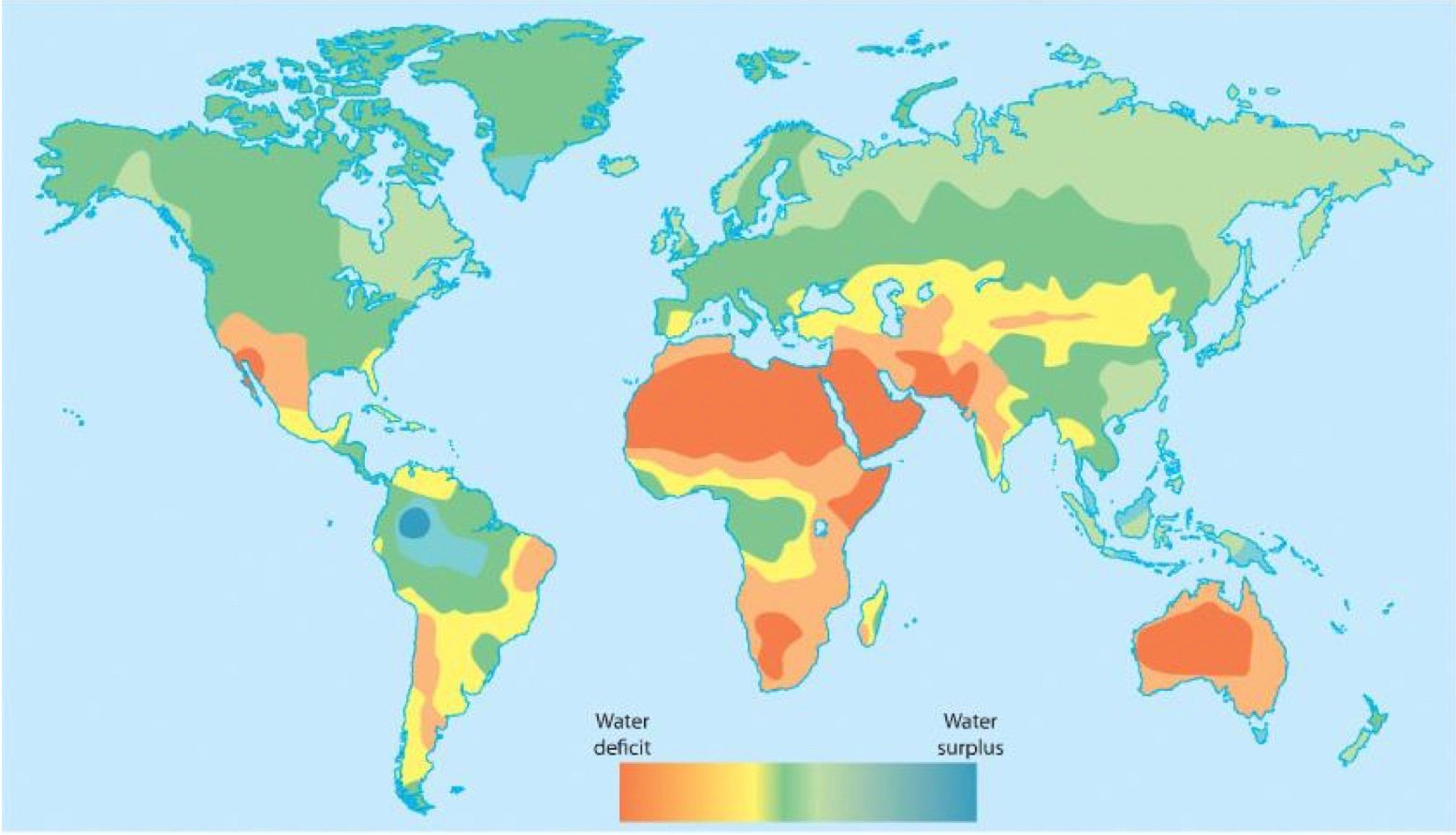Water Shortages and Management
Water shortages (deficit)
- Many areas of the world have water shortages (deficits)
- Water deficit can be due to:
- Low supply - lack of precipitation, high levels of evaporation, poor water management, drought, pollution
- High demand - increasing population, industry and agriculture
- A combination of low supply and high demand
- Areas with the greatest water deficit include:
- Australia
- North, East and South Africa
- Middle East
- South- west USA
- East Brazil, parts of Argentina and Chile
- India
- They tend to be areas around the Tropic of Cancer and Tropic of Capricorn

Water Surplus and Deficit
- There are different levels of water shortage - these are water stress and water scarcity:
- Water stress occurs when the supply of water is below 1700m3 a year per person
- Water scarcity is when the supply is below 1000m3 a year per person
- There are two types of water scarcity:
- When physical access to water is limited due to the climate conditions of the area. This is physical water scarcity
- When a population does not have the money to utilise the available water resources. This is economic water scarcity
- The UN Millennium Development Goals included goal 7 ' Halve by 2015, the proportion of the population without sustainable access to safe drinking water and basic sanitation'
- This goal was not met but access to clean water has improved
- In 2020 74% of the world population now have access to clean water supplies
- In some areas there may be water supply, but this is not potable
-
- UNICEF estimates 2.2 billion people do not have access to potable (clean drinking) water
- Around 4.2 billion people do not have access to safely managed sanitation services
-
- Water scarcity is expected to increase across the world due to:
- Increasing population
- Development increases demand
- Climate change increasing aridity
- Pollution
Causes of water shortage
- Many of these areas have a deficit due to low precipitation throughout the year or drought
- Demand is greater than supply in some countries due to increasing population, industry and agriculture
- In some areas rivers flow through many countries and this leads to issues with water abstraction and other activities. The upstream country may
- Take large amounts of water from the river for agriculture, industry or domestic use leaving less for the country further downstream
- Build dams or alter river flow which impacts on discharge downstream
- Reduce water quality by introducing pollution to the river
- Higher temperatures may lead to increased evaporation and transpiration reducing the amount of water available
- The type of land use - agriculture leads to increased water consumption
- In some countries there is disparity in water supply between areas - China has severe water shortages in the north but water is more available in the south
- Conflict - many of the LEDCs who have struggled to meet the MDG are experiencing conflict
Impacts of water shortage
- There are many impacts of water shortages including:
- Death and illness due to water-borne diseases such as cholera and dysentery
- Potential for conflicts over water supply particularly where countries share a river basin
- Children in rural areas in LEDCs often miss out on school as they are responsible for collecting water (may have to walk miles to the nearest water source)
- Lack of food due to:
- Crops cannot be irrigated and so yields are lower
- Livestock dies due to a lack of water
- Damaged ecosystems and loss of habitats
- Affects economic development as water is not available for industry
Managing water supply
- There are many ways in which water supply can be managed but this is easier in MEDCs where the money to implement these schemes is available
| Water Use | Management to Reduce use |
| Industry | Most water in MEDCs is used for industry. Some of this water could be recycled and used again within the process to reduce consumption |
| Agriculture | Drip irrigation which delivers water to the roots of plants. Irrigation leads to 40% of the water used being lost to evaporation and poor management. Drip irrigation reduces this loss significantly |
| Domestic |
Water efficient appliances Rainwater collection Use of grey water for washing cars and watering plants Low flush toilets and water saving shower heads Water companies fixing leaks and improving efficiency |
- In LEDCs water management is more difficult due to lack of funding
- The involvement of Non-Governmental Organisations (NGOs) such as Water Aid helps to fund projects
- Appropriate technology is essential to manage water in LEDCs, they include:
- Wells
- Gravity fed systems where water is piped from a spring or river higher up a valley
- Boreholes use a hand pump to bring water to the surface
- Rainwater collection from roofs
- Drip irrigation
- Drought resistant crops
Exam Tip
Remember when interpreting maps you need to pay close attention to the key and title.
In the above example the map shows both surplus and deficit of water supply on a sliding scale. Areas of greatest water surplus are dark blue and areas of greatest water deficit are dark orange.


